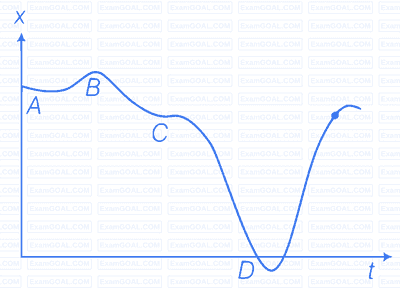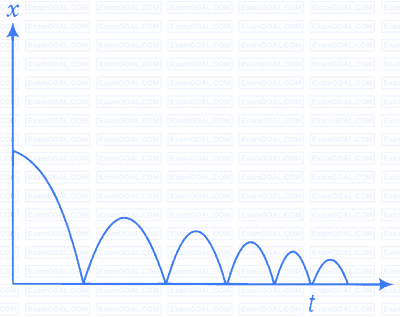Among the four graphs shown in the figure, there is only one graph for which average velocity over the time interval (0, T) can vanish for a suitably chosen T. Which one is it?
A lift is coming from 8th floor and is just about to reach 4th floor. Taking ground floor as origin and positive direction upwards for all quantities, which one of the following is correct?
In one dimensional motion, instantaneous speed $v$ satisfies $0 \leq v < v_0$.
A vehicle travels half the distance $l$ with speed $v_1$ and the other half with speed $v_2$, then its average speed is
The displacement of a particle is given by $x = (t-2)^2$ where $x$ is in metre and $t$ in second. The distance covered by the particle in first 4 seconds is
At a metro station, a girl walks up a stationary escalator in time $t_1$. If she remains stationary on the escalator, then the escalator take her up in time $t_2$. The time taken by her to walk up on the moving escalator will be
The variation of quantity A with quantity B, plotted in figure. Describes the motion of a particle in a straight line.

A graph of x versus t is shown in figure. Choose correct alternatives given below

For the one-dimensional motion, described by $x=t- \text{sin}t$
A spring with one end attached to a mass and the other to a rigid support is stretched and released.
A ball is bouncing elastically with a speed 1 m/s between walls of a railway compartment of size 10 m in a direction perpendicular to walls. The train is moving at a constant velocity of 10 m/s parallel to the direction of motion of the ball. As seen from the ground:
Refer to the graph in figure. Match the following:
| Graph | Characteristics |
|---|---|
| (a) | (i) has v > 0 and a < 0 throughout |
| (b) | (ii) has x > 0 throughout and has a point with v = 0 and a point with a = 0 |
| (c) | (iii) has a point with zero displacement for t > 0 |
| (d) | (iv) has v < 0 and a > 0 |
A uniformly moving cricket ball is turned back by hitting it with a bat for a very short time interval. Show the variation of its acceleration with time (Take acceleration in the backward direction as positive).
Give examples of a one-dimensional motion where
(a) the particle moving along positive x-direction comes to rest periodically and moves forward.
(b) the particle moving along positive x-direction comes to rest periodically and moves backward.
Give example of a motion where x > 0, v < 0, a > 0 at a particular instant.
An object falling through a fluid is observed to have acceleration given by $a = g - bv$ where $g$ = gravitational acceleration and $b$ is constant. After a long time of release, it is observed to fall with constant speed. What must be the value of constant speed?
A ball is dropped and its displacement versus time graph is as shown (Displacement $x$ from ground and all quantities are positive upwards).

(a) Plot qualitatively velocity vs time graph
(b) Plot qualitatively acceleration vs time graph
A particle executes the motion described by $x(t) = x_{0}(1 - e^{-γt})$; $t \geq 0$, $x_{0} > 0$.
(a) Where does the particle start and with what velocity?
(b) Find maximum and minimum values of $x(t)$, $v(t)$, $a(t)$. Show that $x(t)$ and $a(t)$ increase with time and $v(t)$ decreases with time.
A bird is tossing (flying to and fro) between two cars moving towards each other on a straight road. One car has a speed of 18 km/h while the other has the speed of 27 km/h. The bird starts moving from the first car towards the other and is moving with the speed of 36 km/h and when the two cars were separated by 36 km. What is the total distance covered by the bird?
A man runs across the roof, top of a tall building and jumps horizontally with the hope of landing on the roof of the next building which is at a lower height than the first. If his speed is 9 m/s, the (horizontal) distance between the two buildings is 10 m and the height difference is 9 m, will be able to land on the next building? (Take $g = 10 \text{ m/s}^2$)
A ball is dropped from a building of height 45 m. Simultaneously another ball is thrown up with a speed of 40 m/s. Calculate the relative speed of the balls as a function of time.
The velocity-displacement graph of a particle is shown in the figure.
(a) Write the relation between $v$ and $x$.
(b) Obtain the relation between acceleration and displacement and plot it.

It is a common observation that rain clouds can be at about a kilometer altitude above the ground.
(a) If a rain drop falls from such a height freely under gravity, what will be its speed? Also calculate in km/h $(g = 10 m/s^2)$.
(b) A typical rain drop is about 4 mm in diameter. Momentum is mass $\times$ speed in magnitude. Estimate its momentum when it hits ground.
(c) Estimate the time required to flatten the drop.
(d) Rate of change of momentum is force. Estimate how much force such a drop would exert on you.
(e) Estimate the order of magnitude force on umbrella. Typical lateral separation between two rain drops is 5 cm.
(Assume that umbrella is circular and has a diameter of 1 m and cloth is not pierced through.)
A motor car moving at a speed of 72 km/h cannot come to a stop in less than 3.0 s while for a truck this time interval is 5.0 s. On a highway, the car is behind the truck both moving at 72 km/h. The truck gives a signal that it is going to stop at emergency. At what distance the car should be from the truck so that it does not bump onto (collide with) the truck. Human response time is 0.5 s.
A monkey climbs up a slippery pole for 3 s and subsequently slips for 3s.
Its velocity at time t is given by $v(t) = 2t(3s - t)$; $0 < t < 3$ and $v(t) = - (t - 3)(6 - t)$ for $3 < t < 6$ in m/s. It repeats this cycle till it reaches the height of 20 m.
(a) At what time is its velocity maximum?
(b) At what time is its average velocity maximum?
(c) At what time is its acceleration maximum in magnitude?
(d) How many cycles (counting fractions) are required to reach the top?
A man is standing on top of a building 100m high. He throws two balls vertically, one at $t = 0$ and after a time interval (less than 2 seconds). The later ball is thrown at a velocity of half the first. The vertical gap between first and second ball is $+15$ m at $t = 2$ s. The gap is found to remain constant. Calculate the velocity with which the balls were thrown and the exact time interval between their throw.